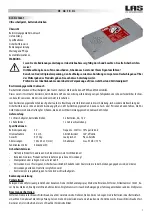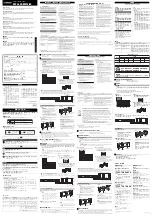
8-34
D60 Line Distance Protection System
GE Multilin
8.5 SINGLE-POLE TRIPPING
8 THEORY OF OPERATION
8
8.5.5 PILOT SCHEME / PHASE SELECTOR COORDINATION
For local fault type identification the pilot schemes use the Phase Selector. The latter may fail to respond to certain fault
scenarios. Examples are: simultaneous forward and reverse fault, simultaneous SLG and LL fault involving different phases
(e.g. AG and BC) or two simultaneous faults in the same direction but at very different locations. The Phase Selector is opti-
mized to either indicate correctly the forward fault or to assert the Void flag. For example, a combination of AG and BC is
not a valid fault type - it is two different simultaneous faults and as such cannot be described by any single fault pattern,
therefore, the Phase Selector would assert the Void flag.
The VOID phase selection combined with a local trip request (such as high-set directional overcurrent) will result in three-
pole trip as per the Trip Output logic.
The Pilot Schemes, however, try to recover more information from the distance elements. Each scheme uses a forward
looking, either underreaching or overreaching, distance zone. A given Pilot Scheme analyzes this zone for fault type identi-
fication if the Phase Selector asserts its Void flag: the DUTT scheme uses Z1; all the other schemes use Z2. The schemes
analyze all six fault loops of the zone to determine the fault type.
For example, simultaneous forward AG and reverse BG faults may result in the Void indication. The POTT scheme would
analyze the Z2 response. As only the AG element is picked up, the local phase selection is determined as AG. This is a cor-
rect indication.
Depending on the number of bits used for communications, the accuracy of the overall response will be further improved as
illustrated in the next subsection.
This enhanced operation of the pilot-aided schemes is the reason to use a short pilot scheme priority time when setting the
Trip Output logic. The timer will force the scheme to wait for a decision from the pilot scheme for a short period of time
before accepting any local trip request. The advantage, however, materializes only if more than one-bit communications
channels are used, and is important only on parallel lines or when the application requires maximum accuracy of single-
pole tripping. In other cases, it is not recommended to delay the local trip decision.
Содержание D60
Страница 61: ...GE Multilin D60 Line Distance Protection System 2 31 2 PRODUCT DESCRIPTION 2 3 SPECIFICATIONS 2 ...
Страница 62: ...2 32 D60 Line Distance Protection System GE Multilin 2 3 SPECIFICATIONS 2 PRODUCT DESCRIPTION 2 ...
Страница 102: ...3 40 D60 Line Distance Protection System GE Multilin 3 3 DIRECT INPUT AND OUTPUT COMMUNICATIONS 3 HARDWARE 3 ...
Страница 134: ...4 32 D60 Line Distance Protection System GE Multilin 4 3 FACEPLATE INTERFACE 4 HUMAN INTERFACES 4 ...
Страница 508: ...5 374 D60 Line Distance Protection System GE Multilin 5 10 TESTING 5 SETTINGS 5 ...
Страница 538: ...6 30 D60 Line Distance Protection System GE Multilin 6 5 PRODUCT INFORMATION 6 ACTUAL VALUES 6 ...
Страница 610: ...10 8 D60 Line Distance Protection System GE Multilin 10 2 BATTERIES 10 MAINTENANCE 10 ...
Страница 622: ...A 12 D60 Line Distance Protection System GE Multilin A 1 PARAMETER LISTS APPENDIX A A ...
Страница 745: ...GE Multilin D60 Line Distance Protection System B 123 APPENDIX B B 4 MEMORY MAPPING B ...
Страница 746: ...B 124 D60 Line Distance Protection System GE Multilin B 4 MEMORY MAPPING APPENDIX B B ...
Страница 776: ...C 30 D60 Line Distance Protection System GE Multilin C 7 LOGICAL NODES APPENDIX C C ...
Страница 792: ...E 10 D60 Line Distance Protection System GE Multilin E 1 IEC 60870 5 104 PROTOCOL APPENDIX E E ...
Страница 804: ...F 12 D60 Line Distance Protection System GE Multilin F 2 DNP POINT LISTS APPENDIX F F ...
Страница 826: ...xii D60 Line Distance Protection System GE Multilin INDEX ...
















































